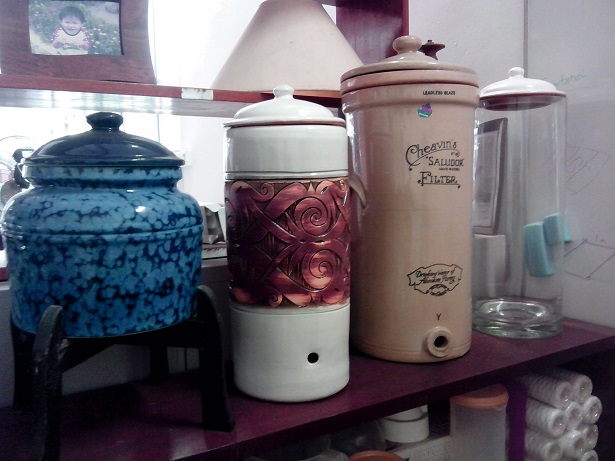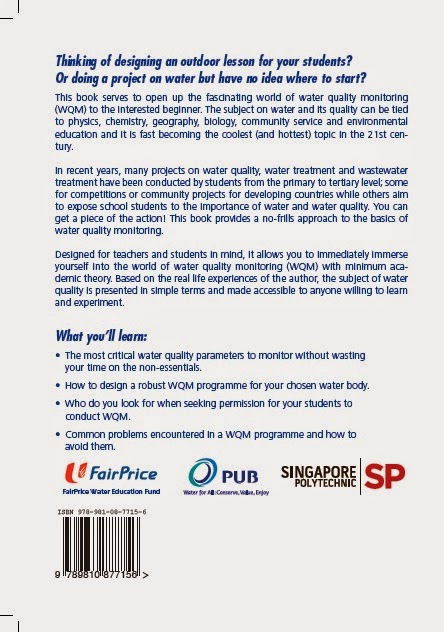Our students are really lucky these days to have many opportunities to go overseas. We have acronyms like YEP (youth expedition project) (funded by MCYS), OCS (overseas community service), OCIP (overseas community immersion programme), OITP (overseas industrial training programme) plastered around campus, encouraging our students to sign up. In addition, we have more of the overseas outdoors variety of activities e.g. leadership camp, adventurers camp, mountain climbing, too.
Especially for YEP/OCS where the participants (students & staff) get to live close to the community they serve (read rural and undeveloped), they will stand next to the pond/stream/cistern/faucet/pail (take your pick) and ask, "
Is that water safe?" Unfortunately, the answer may not be so straightforward.
Let's answer that question with another question, "
Safe for what?"
For the brevity of this post and the significance of the intended use, let's restrict ourselves to "
safe for drinking".
Water quality (WQ) parameters
If you are going to test the water according to
WHO drinking water guidelines (more about the testing of water in an
earlier post), you are going to find yourself wading in deep cess. You have close to 200 WQ parameters to test and the a complete set of tests will burn a big hole in your pocket. Fortunately, I can share some tips here to make your judgement easier or at least drastically reduce the kind of tests you need to make.
Sources of water
- Rainwater
This is the cleanest form of natural water. The processes of evapotranspiration and condensation in the water cycle is effectively a form of distillation. The only concerns will be air pollutants (e.g. acid gases, particulates). Acid gases will of course make the water acidic while particulates may contain heavy metals that go into rain. But the effects are likely to be small compared to the potential problems encountered in the next few sources. Hence, I would still put my bet on rainwater as a viable drinking water source among the various natural sources. This is also why I strongly advocate rainwater harvesting in communities that lack a reliable and safe source of drinking water.
- Surface water: Pond, stream, lake
I would check (ask the locals, check the map etc.) the upstream and the surroundings. Are there residences, industries, agriculture or other human activities? These can release human waste, animal waste, industrial waste, pesticides and other nasty stuff. Unless near the headwaters (usually thick jungles in the tropics), surface water tends to be turbid and contains an unhealthy does of bacteria. These are 2 good WQ parameters to measure if you still want to use surface water (perhaps combining with some sort of treatment). And if there are industries and agriculture around or upstream, you can add heavy metals, pesticides, oil, detergents, fertilisers into your to-do list of WQ testing.
(Digression: Incidentally, I have seen outdoor activities being conducted with the participants immersed in a river (i.e. primary contact) in other countries. Hopefully, the organisers have bothered to check what is upstream of that river in case the participants gulp down mouthfuls of river water containing human waste from the village upstream.)
- Groundwater: well, spring
Generally less turbid and has less harmful bacteria than surface water. However, it may contain heavy metals (e.g. lead) that occur naturally in the ground. Depending on presence of arsenic deposits in your area (developed countries e.g. USA are not spared either), your groundwater may contain a dangerous concentration of arsenic.
On the other hand, the presence of human activities e.g. industries can also lead to leaching of toxic chemicals (think organic solvents, pesticides, electroplating wash) into groundwater. This is especially true if the industry does not have a habit of cleaning up their act e.g. dumping waste into the ground like nobody's business instead of treating or sending it for proper disposal.
- Man-made outlet: faucet, cistern
Hey, the water must come from somewhere right? Is rainwater harvested and stored in the cistern? Or is there a pipe that conveys the water pumped from a well or stream? Maybe the nearby spring is diverted to come out from the faucet?
Make the effort to find out the origins of your water and see if they come from any of the above 3 sources.
Finally, your community/village may be lucky enough to have piped water from a water treatment plant! This may or may not be good news though. For one thing, it is hard to tell if the water treatment plant is doing a good job without doing any actual WQ testing. The locals may be able to advise you but then again, their bodies may have adapted to the water (clean or otherwise) and some effects do not appear in the short term.
Note that not all water treatment plants are built alike or at least they are not built like our PUB plants which are considered effective and produce water of adequate drinking standard. I have heard of water treatment plants in other countries that add massive doses of chlorine to kill the germs but do little else to clean up their water. Well yes, you have germ free water but that heavy dose of chlorine will probably give you cancer years down the road.
I will continue in more future posts on this topic
Figure 1: Sand filter at our local water treatment plant at Chestnut Drive (see
previous post).
Figure 2:
Binjai Stream - this part is close to the headwaters so the water is relatively clean and clear, flowing over a sandy bed.
Figure 3:
Ngee Ann Stream - this is further downstream from the headwaters. Note the obvious turbidity.














